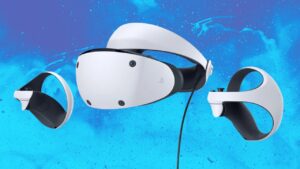Titanfall 2 is a giant among shooters thanks, in part, to its near-flawless depiction of the ultimate power fantasy: causing untold destruction with a massive, gun-toting mech. But Titanfall 2’s very best moments occur when you’re stripped of your walking tank and must survive its industrial sci-fi universe as a mere squishy human.
Into The Abyss, Titanfall 2’s fourth mission, is one of these moments, and marks a monumental achievement in mission design for developer Respawn Entertainment. Set in a factory suspended above an infinite void, a gauntlet of deadly fabrication machines acts as a thrilling and creative showcase for Titanfall’s ambitious movement systems.
To find out how Into The Abyss was put together, IGN spoke to game designer David Shaver, who co-designed the mission with three other developers at Respawn. With his insight, let’s take a look at how this level defies shooter traditions, teaches and reinforces first-person platforming skills, and builds contrasting experiences around movement abilities, all to create one of the most exhilarating FPS campaign missions of all time.
While perhaps not as famous as the time-hopping Effect and Cause, Into The Abyss is one of Titanfall 2’s most complex and demanding missions. A level almost wholly focused on the incredible mobility of your pilot, it’s made up of three distinct sections: the continually shifting assembly line of the World Foundry; the Simulation Dome live-fire training facility, and an escape set piece that culminates in a titan vs titan smackdown. Together, these three segments form a fascinating, memorable mission with a unique approach to movement and momentum.
Into The Abyss is the product of Respawn’s ‘action blocks’, a prototype system in which ambitious, isolated concepts were quickly built and tested. If an action block resonated with the team, it would evolve into a mechanic or a mission for Titanfall 2’s campaign.
During the early days of development, Mohammad Alavi, the designer behind Call of Duty’s iconic All Ghillied Up and No Russian missions, created an action block that featured a titan bursting through a wall as part of a prototype for destructible environments. Fellow game designer David Shaver loved the idea, but knew it was too technically demanding to implement across the entire campaign. And so he began thinking about how he could build a single level around robotic demolition.
“
“I actually remember the original pitch that I came up with for the level, which I code named BoomTown,” recalls Shaver. “You and BT would be fighting against another Titan, and it’d be kind of like this cool Transformers fight. You’d be smashing through buildings. And then I had the idea ‘Well, once you’ve smashed through the buildings, that’s going to be a boring fight because now the cover’s gone and now the levels are gone.’ I was like, ‘What if they replace themselves? Or what if we got new ones?’ So I started thinking about those training facilities, you see the military, they’ll prop up replicas of buildings and things with cheap plywood and two by fours.
“I was like, ‘What if we make it so that it’s sort of a live fire testing facility, like the training ground Titanfall 1 map, but it changes. Once a building is destroyed, it brings up a new one, or they drop in a new one.’ We had no idea how it would deliver, but a new one would appear, and then you’d fight. And then it just snowballed from there. And then it was like, ‘What’s building these things? Maybe we should investigate what’s down there.’ And so that birthed what I called the World Foundry, which is the factory that builds all this stuff.”
Shaver, along with design partners Chris “Soupy” Dionne, Jason McCord, and Chad Grenier, worked to turn that concept into a complete mission. They plotted out a level made up of that World Foundry factory, the Simulation Dome it was building, and a cataclysmic escape sequence that would end with a boss fight.
But the idea of BoomTown eventually underwent a huge shift. Ironically for a prototype that began life as two titans fighting, Shaver and the team decided to take away the key feature: your beloved titan, BT-7274.
Solo Pilot
“At the beginning of the level, you’re with BT, you’re exploring this mystery,” says Shaver. “And then the robot arm grabs BT and takes him away, and now you’re like, ‘Oh crap, I don’t have my super Iron Man armour anymore. What am I going to do?’
“Most of the prototypes that we had for this level really, really shined when BT either wasn’t there or he was helping from a distance or something,” he explains. “And so that’s what we rolled with for this level. ‘Okay, this level’s mostly about pilot mobility and combat around moving stuff, to get the player ready for the rest of the game. We can focus on that.’”
With BT in the clutches of mission villain Ash, you’re forced to rely solely on the abilities of protagonist Jack Cooper, a titan pilot. Thanks to a small jetpack you’re incredibly agile, able to double-jump over long distances and run along walls as if in the Matrix. It is these skills that the factory floor of the World Foundry was built to train and test.
“We watched streamers and people playing the game during our playtests and a lot of times they struggled with wall running,” Shaver recalls. “And so it was like, ‘Okay, well we need to get people [comfortable] with wall running because that’s a core mechanic of Titanfall, and we really want them to be able to do it because if they go into multiplayer, they’re going to get owned without it.’”
The original Titanfall had already proved that the player skill ceiling was incredibly high. To train people up to a reasonable standard, the obstacles of Into The Abyss had to be absolutely wild. But it wasn’t the rocket-propelled antics of Quake or Unreal Tournament that inspired its gauntlet of jumps and wall runs: it was a 1999 comedy sci-fi movie.
“One of the inspirations was Galaxy Quest,” Shaver reveals, “where Sigourney Weaver and Tim Allen run into this area in the ship and it’s just crazy chompers and fire, and you were like, ‘Why would anybody build this?’ I love that movie. So that’s one of the inspirations for this, I was just like, ‘Let’s have some of that fun in here.’”
“So the stompy thing was an action block. The roller that was applying dirt and grass was an action block. You stop and robot arms are putting on furniture and walls, that was an action block. The sideways town climb itself was an action block. So we basically were like, ‘Okay, we’ve got all these really cool pieces, let’s stitch them together like Lego blocks.’”
Each new piece of machinery escalates the pace and difficulty. The first is a simple platform jump that you can simply ride to your destination, but you’re soon forced to chain together a jump, wall run, and landing to bypass the turf-laying machine. A further challenge has you wall running between platforms that shift between vertical and horizontal orientations, challenging your agility, timing, and positioning. And all of this happens over a deadly drop into an infinite void, which adds edge-of-your-seat tension to effectively teach the importance of linking together moves.
“
But before escaping the factory, another two other important lessons are taught. The first comes in the form of the houses that are progressively assembled around you. Walls and furniture slot into place, completely altering your surroundings every few seconds.
“We’re teaching the player that the environment is changing, you can’t trust it’s going to be there, so keep looking around,” Shaver explains. “One of the main things it does is it creates a feeling of uncertainty and dread and instability. That was one of the feelings in the factory, it was just like, ‘I am in danger, I really want my Titan.’ And so that down moment in the player’s psyche sets up the up moment of returning to BT later. You’re like, ‘Holy crap, I can’t believe I survived this.’”
The World Foundry’s final trial is the ‘sideways town’, designed by Dionne. This head-spinning segment has you running upwards through a town mounted to the wall, creating some Inception-like visuals. But it was important to push players through this unusual bit of environment design in order to practically demonstrate how Titanfall 2 rethinks the fundamentals of FPS design.
“When you play a game, a classic shooter like Doom […] the top third and the bottom third of the screen aren’t really that dangerous. But in Titanfall the top two thirds of the screen could be a threat from any direction, pilots are flying through the air as they wall run above you and shoot from above.”
Don’t Fear The Reaper
Conquering the sideways town climb lifts you out of the darkness of the World Foundry and into the artificial sunlight of the next segment of Into The Abyss: the Simulation Dome.
“We wanted to lead up to this culmination of like, ‘Where is all this crap going? Why is all this stuff getting built?’” explains Shaver. “We wanted to just celebrate getting through the factory with, ‘This is what it’s used for, guys. Now, you get to go play in it.’”
But the Simulation Dome is more than just a story set-piece. It’s the stage for your first fight with a brand new enemy type, a foe more dangerous than almost anything you’ve faced before: the Reaper.
“We needed to make it more of a moment where players could learn how to interact with the Reaper,” Shaver says. “Because the Reaper has specific anti-pilot things about it, it can shoot projectiles that you can dodge, and it throws Ticks to get you when you go into smaller areas and it flushes you out. And then it can also leap at you and slam the ground and stuff. So I needed to teach the movement, I needed to teach all of these mechanics to the players.”
This lesson requires an environment that’s in direct opposition to the one you’ve just escaped. Where the factory is in a state of constant movement, the Simulation Dome is static. Rather than a linear pathway with a dictated route, the Dome is a large, open space through which you can travel at your own pace and in any direction. In just a few minutes, the Factory’s rollercoaster thrills are traded for a miniature sandbox skirmish—creating a memorable juxtaposition that highlights two very different sides of Titanfall’s identity.
The Simulation Dome’s skirmish is the stage for a demonstration of Titanfall 2’s combat flow. While designing the incoming waves of IMC soldiers, robots, and Reapers, Shaver looked to an unusual source of inspiration for a shooter: God of War.
In the original God of War trilogy, Santa Monica Studio blurred the lines between waves of enemies to create the sense of a continuous horde. For instance, when fighting a Cyclops, the game would spawn in a second Cyclops when the first was down to around 10 percent health. This would momentarily provide the spectacle of fighting two massive monsters, but with no real difficulty spike since the first Cyclops would soon die. This approach informed how Shaver scripted big enemies into the Simulation Dome.
“
“So [in] the Reaper fight, we spawn the first one, and then I drop in some Spectres and they fight,” details Shaver. “And then once that gets going and once the Reaper is at a certain level of health, we spawn another one, we spawn more Spectres. […] That fight took a lot of scripting time. I spent weeks and weeks, if not months, trying to get the right balance because a lot of people in Respawn found it way too hard.”
“Hopefully, if I did my job right, you don’t really notice that it is kind of waves, but it’s just been going as you’re fighting,” Shaver says. “There’s a lot of scripting on the back end, watching how many Spectres are there? How much health is on the Reaper? Oh, we’re low in Spectres, drop a couple more, that kind of thing to keep it going. Because what was really not fun was when you killed everything and then it’s just quiet. And then there’s a pause, an awkward pause. And it’s like, ‘Oh I see that. You’ve got them all, I will send more.’ And that’s just really awkward. So I was trying really hard to avoid that.”
Victory in the Simulation Dome brings with it a huge sense of relief, an emotion elevated by your long-awaited reunion with BT. Strapping back into your titan marks the start of Into The Abyss’ finale, which taps directly into the brand of dramatic, destructive cinema that’s part of Respawn’s Call of Duty heritage.
Rumble Robots
Having witnessed you defeat waves of IMC soldiers, Ash begins the destruction of the World Foundry. As the facility begins to fall apart, you and BT sprint through numerous collapsing Simulation Domes in desperate hunt of an escape route. It’s a sequence in which Shaver really wanted to evoke a genuine sense of danger.
“The idea was that we can give the player a taste and get the idea across that, ‘Hey, this place is really unstable, it’s coming down, you need to get the heck out of here,” says Shaver.
“I’m doing everything I can to sell that this place is falling apart. I’ve got rocks falling, explosions happening and sky panels falling and stuff,” he adds.
“There’s even IMC grunts evacuating drop ships and stuff. We’ve got them running to get out and flying away.”
“And then [you] run into Ash and be like, ‘Oh no, here’s our gatekeeper. She’s going to stop us from getting out of here.’”
Jason McCord was on design duties for the final location of the level; a collapsed urban Simulation Dome in which you fight Ash in her sword-swinging Ronin titan. This was to be a full-on, no holds barred mech showdown, and the slower, more cumbersome movements of the titan would act as a complete contrast to the previous, more nimble sequences. Catering for the lumbering mechs and their rocket-boosted dodges would require a very different approach to level design, and so the arena features simple lines and wide lanes. A route around the map allows both titans to circle around each other, keeping one another within their sights.
As the design for this battle was further developed, Ash gained a terrifying new ability that meant McCord had to rethink how the landscape was designed. And, as with so much of Into The Abyss, this new ability was all about movement.
“Once Ash got the phase ability, she could phase and just reappear next to you,” Shaver explains. “And it was terrifying and she was really hard. We had to tone her down a little bit because she would just completely destroy you. And so having an arena that was designed with that ability in mind, so that you could funnel the player’s view [so] if she does phase you’re not looking completely 90 degrees in the wrong direction from where she’s going to appear, it’s going to be somewhere, hopefully in your view that she’s going to re-phase and give you a moment to react.”
The final version of the Ash boss fight arena features a sloped design, which provides a lot of high ground. The destruction of the Dome’s buildings, combined with the added height of your titan, opens up sightlines across the intersecting roads, providing wide viewing angles. The layout dulls the brutal edge of Ash’s phase ability, overcoming Respawn’s difficulty worries. But the arena design arguably makes this an incredibly easy boss fight; a quick skirmish that, while endinging in fireworks, is a final battle that pales in comparison to the level’s previous trials. This contrast pushes Titanfall 2’s movement systems fully into the limelight. As fantastic as it feels to wield the colossal power of a titan, it’s in the agile pilot gameplay that Titanfall 2 truly crushes it.
That’s not something that passed Respawn by. Into The Abyss was lauded internally, and used as a ‘vertical slice’ to inspire and set a quality bar for other level designers. Its position within the campaign acts as a gateway; after a relatively traditional opening, Into The Abyss triggers an explosion of creativity, paving the way for layered, agility-based masterpieces like the time-hopping Effect and Cause and the ship-to-ship leaps of The Ark.
But even in a campaign full of astonishing ideas, Into The Abyss shines bright. Its gauntlet of varied agility challenges, from the deadly contraptions of the assembly line to the intense flanking routes that run through the Simulation Dome, make movement the undeniable star of the show. And through a collection of inspired design elements, the level redefines even the most fundamental of FPS assumptions. Up isn’t just a place you should look, it’s a place you should go. By rethinking those basics, Respawn did the impossible: it made first-person platforming not just work, but somehow the best part of a game that features massive fighting robots.
Matt Purslow is IGN’s UK News and Features Editor.











